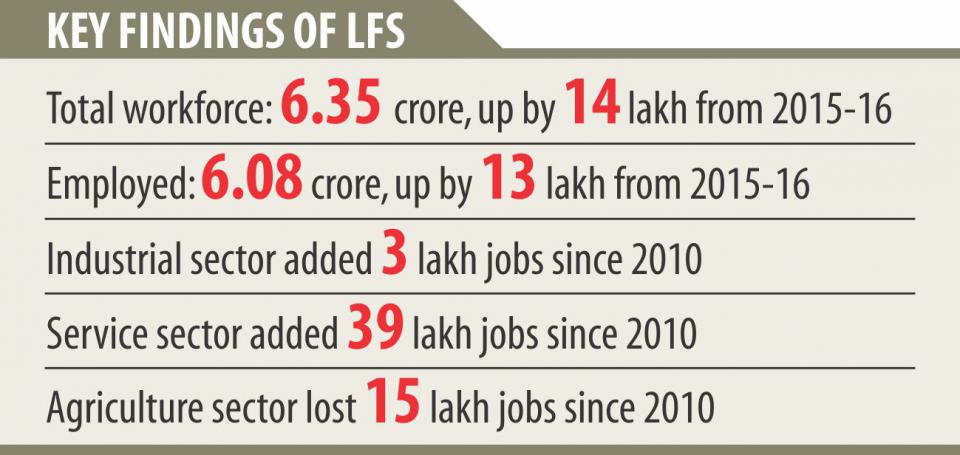
Employment growth in industrial sector slowed further in fiscal year 2016-17 for the second year in a row, in a sharp U-turn from its previous growth record, according to the Labour Force Survey released by the Bangladesh Bureau of Statistics last week.
Sluggish private investment, rise of capital intensive sector and adoption of advanced technologies are three key reasons behind this, experts and analysts said.
The industrial sector, which was a major employment generator between 2000 and 2010, employed only 3 lakh people in the last seven years till FY 2016-17. On average, the sector created 42,857 jobs a year during the period.
In the previous seven years till 2010, it created 8.71 new jobs, the survey said.
As a result of this reversal, industrial sector's share of employment fell to 20.4 percent in 2016-17, down from the highest 23 percent recorded in 2013.
The share of agriculture in the job market also dropped.
On the other hand, service sector created the highest number of jobs.
Such a trend is unexpected in a country that has an abundant labour force, analysts said.
“The economy is yet to reach a saturation point of creating employment. Bangladesh is now a low-middle income country and its share of industrial sector employment should increase until it becomes an upper-middle income country,” said Zahid Hussain, lead economist of the World Bank in Dhaka.
In recent years, countries such as China, Indonesia and Vietnam are creating more jobs in industrial sector. “Service sector dominates in high income economies. We are way behind that saturation point,” he added.
The survey found that 14 lakh new faces joined the labour force between 2015-16 and 2016-17, taking the total number to 6.35 crore.
Of the total, 6.08 crore have jobs while 27 lakh are fully unemployed, up by 1 lakh from a year ago.
However, the overall unemployment rate remains steady at 4.2 percent, according to the BBS.
And although agriculture's share in the employment pie has shrunk, it still accounts for the highest number of jobs -- 40.6 percent of the total employed population recorded in 2016-17.
Service sector employed 2.37 crore people as it added 17 lakh jobs from 2015-16.
As a result, the share of service sector rose 2.1 percentage points to 39 percent in 2016-17, as the sector secured the share lost by agriculture and industrial sectors during the period.
Zahid Hussain said two factors -- flaws in statistics and capital intensive growth of the industrial sector -- might help explain the fall in industrial sector employment.
He pointed out that the economy grew by over 7 percent in the past two fiscal years, led by a double-digit growth of industrial sector. Yet, the sector could not create enough jobs.
At the same time, export of apparels, the main industrial item, had been sluggish. “This raises doubts about the industrial growth figures as we do not see employment growth to that extent.”
He said domestic market oriented and import substitute industries may have driven the industrial sector growth in the last two fiscal years.
These are capital intensive sectors, not labour intensive, he said citing pharmaceuticals, steel and cement industries.
Rushidan Islam Rahman, executive chairperson of the Centre for Development and Employment Research, said a fall in the share of employment in industry meant that the scope for regular and formal employment was on decline.
“This is happening for a lack of growth of labour intensive industries. So steps should be taken to raise incentives for diversified industrial growth,” she said.
The declining trend of industrial sector employment is alarming for economy, said Khondaker Golam Moazzem, research director at the Centre for Policy Dialogue.
Employment rate in industrial sector slowed down over the last five years, as businesses adopted advanced technologies and went for automation for higher productivity, he noted.
“Unskilled and women workers are losing jobs as they can't adjust with the changing atmosphere,” said Moazzem, adding that CPD too found that employment was falling in industrial sector.
Shamsul Alam, member of General Economic Division of the planning ministry, said demand for physical labour was decreasing as a result of adoption of technology by industries.
Also, some people might have shifted from industrial sector to service sector, which offers more benefits such as incentive, reward, and higher salary, he added.
“Inadequate private sector investment in the industrial sector in general and manufacturing sector in particular is leading to this decline in industrial employment,” said Prof ATM Nurul Amin, chairperson of economics and social sciences at BRAC University.
This is forcing the labour force, particularly the poor, to create their own employment in the informal sector, he said.
“This shows how precariously people are making a living by working in the unstable, low-productive and low-income informal sector despite steady economic growth and development. So the content of this growth and development is meaningless for the vast majority of working poor and low-income citizens,” he noted.
